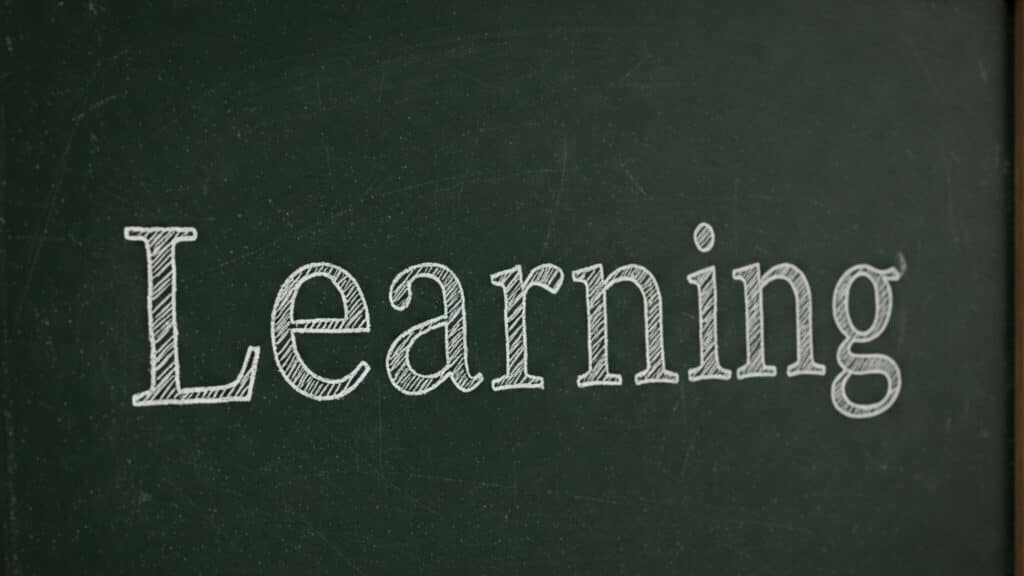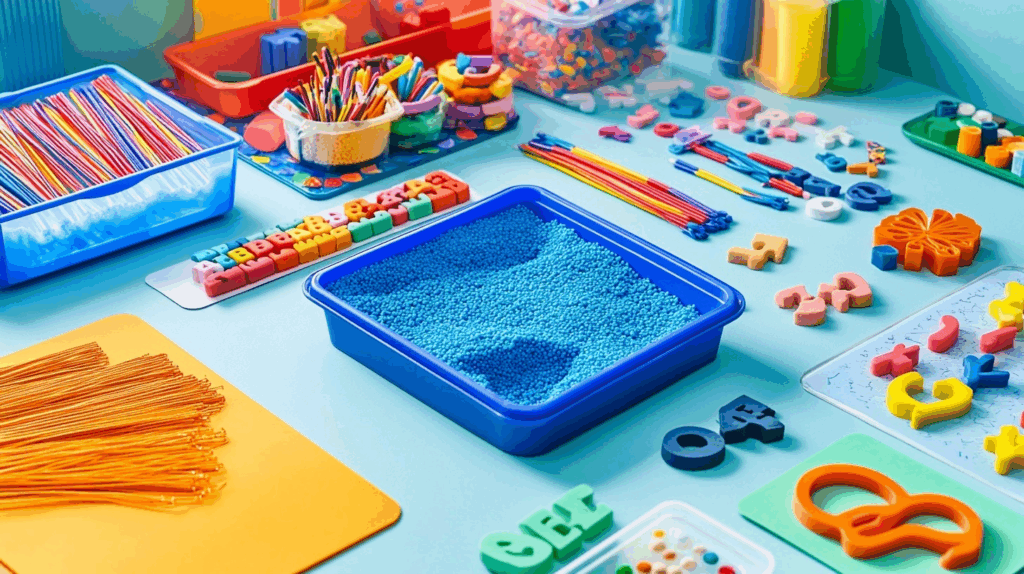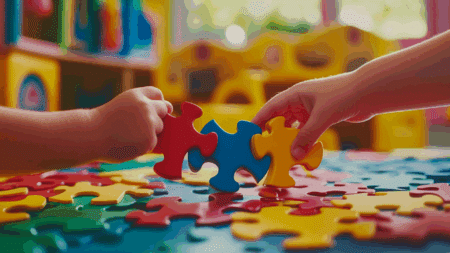Want to see students jump out of their seats for language class?
Most teachers watch helplessly as kids yawn through spelling tests and vocabulary drills. Their eyes glaze over, pencils drag, and learning stops cold.
Word work activities flip this common scene upside down!
When students touch, move, and play with letters, magic happens. These hands-on tasks convert dull language lessons into engaging opportunities for growth.
What is Word Work?
Word work activities are a set of hands-on activities that help students learn about words and how they function. It focuses on teaching students to notice patterns, make connections, and understand how words work.
These activities include sorting words by sounds, building new words with letter tiles, hunting for word patterns, and playing with word families.
Students might cut letters, move magnetic pieces, or use dry-erase markers to learn.
Word work differs from old-style worksheets because it gets students physically involved with language. They touch, see, and hear words all at once, which helps their brains make stronger connections.
The Science Behind Word Work Activities

Studies show that students learn best when they use multiple senses. When kids see, hear, say, and touch words, they form stronger mental links. This helps them recall and use words more easily later on.
Brain research backs this up. When students work with words through various activities, different parts of their brains light up and work together.
This creates what scientists call “neural pathways” – roads in the brain that make learning stick.
Key research findings about word work:
- Students retain 75% more information when they learn through hands-on methods
- Visual-motor skills improve by 40% with regular word work practice
- Memory tests show twice the recall rate for words learned through active methods
- Brain scans reveal higher activity in learning centers during physical word tasks
- Students show less stress and more joy when learning a language this way
No-Prep Wonders: Word Work Activities

1. Word Tile Spelling
Use letter tiles (like Scrabble or Bananagrams) to build each word. The physical motion helps students see how words are constructed. Children feel more confident when they can move letters around to fix mistakes without erasing. This method works well for students who need to touch objects to learn effectively.
2. Pop-It Spelling
Pop a bubble for each sound in a word using a Pop-It fidget toy, then write the corresponding letter. Students love the satisfying popping sensation, making this perfect for fidgety learners. The physical action helps them break words into individual sounds.
3. Playdough Words
Roll and shape playdough into letters to spell each word. This method engages multiple senses – touch, sight, and even smell if you use scented playdough. Students strengthen their hand muscles while learning letter formation.
Students can form one long snake and shape it into the entire word, build letters that stand up rather than lying flat, or press items like pasta or beans into playdough letters for extra texture and interest.
4. Magnetic Letters
Build each word using magnetic letters on a cookie sheet or whiteboard. Students can easily rearrange letters to try different combinations until the word looks right. This method supports experimental spelling and pattern recognition.
- Make full sentences with magnetic words
- Hide magnets around the room for students to find and spell
- Group words by pattern or feature
5. Pattern Block Words
Use pattern blocks to build the shape of each word. Each letter becomes a colorful geometric design, appealing to visual learners. Students notice how letters differ in shape and size, supporting better letter discrimination.
6. Cut and Spell
Cut out printed letters and glue them in order to spell each word. This activity builds fine motor skills while reinforcing letter recognition. Students who struggle with handwriting often find success with this method.
The permanent nature of gluing helps children commit to their spelling choices. Find and cut letters from magazines, use textured paper or fabric for sensory input, or create word puzzles by cutting completed words for reassembly.
7. Rainbow Writing
Write each word multiple times, using a different color for each letter or repetition. This visual approach helps students notice details in word spelling. The color changes keep the brain engaged during repetitive practice.
Students who enjoy art particularly connect with this method. They can use specific colors for vowels and consonants, apply the technique to writing full sentences, or write in rainbow color order from red to violet.
8. Word Illustrations
Draw a picture to represent each word and write the word below the illustration. This creates a visual memory hook connecting meaning to spelling. The brain remembers information better when linked to images.
Students create personalized connections to words through their drawings. They might illustrate words within a short story, create a rebus puzzle with part drawings and part words, or show action words through motion lines.
9. Fancy Spelling
Write each word in “fancy” or cursive handwriting, adding swirls or decorations. This technique slows students down, making them pay attention to each letter. The decorative element adds fun to what might otherwise feel like a chore.
10. Word Pyramids
Write each word in a pyramid shape, adding one letter per line. This method breaks words into manageable chunks. Students see how words are built letter by letter. The visual pattern helps with letter sequencing.
This technique works especially well for students who feel overwhelmed by longer words. Teachers often use this method to help students tackle multisyllabic words.
11. Spiral Spelling
Write the word repeatedly in a spiral pattern, starting from the outside and working inward. The repetitive motion helps build muscle memory for spelling. Students find the pattern visually pleasing and calming.
This method engagingly combines art and spelling. The spiral provides a natural organization for multiple repetitions. Teachers report this works well as a warm-up activity.
12. Scribble Spelling
Write each word inside a different colored scribble or doodle on paper. The colorful background makes the word visually distinct. Students enjoy the creative aspect of making unique scribbles.
This technique works well for visual learners who need to see words as distinct shapes. Teachers often use this for high-frequency words that students need to recognize instantly.
13. Ghost Spelling
Write each word with a white crayon, then color over it with a marker to reveal the word. The activity feels like magic to young learners. The reveal moment creates excitement and reinforces the correct spelling.
For the technique to work, students must write carefully with the crayon. This method especially engages students who might otherwise find spelling practice boring.
14. Paint Strip Puzzles
Write words on paint strips, cut apart, and have students put the pieces back together. This activity helps students notice word parts and letter sequences. The colorful backgrounds help distinguish different words.
15. Build, Cover, Spell
Build the word with magnet letters, cover it, and then write it from memory. This method strengthens visual memory for spelling patterns. Students see, replicate, and recall in sequence.
The immediacy of self-checking helps reinforce correct spelling. Teachers report this helps students who tend to rely too heavily on sounding out words. The method builds confidence as students see their memory improve with practice.
16. Guess My Word
Play a guessing game with a partner, asking yes/no questions to figure out the secret word. This game builds word analysis skills and vocabulary. Students must think about word features like letters, patterns, and meanings.
Category clues, first letter hints, and twenty-question limits add structure to this engaging activity. The game format makes spelling practice feel like play.
17. Roll It
Assign each word to a number on a die. Roll and write the word that matches the number. The element of chance makes practice more exciting and unpredictable. Students stay engaged because they don’t know which word comes next.
Double dice provide more word options. Students might write both the word and its meaning, or roll to determine both the word and the writing style. This method works well for independent practice during center time.
18. Speed Read
Time yourself or a partner to see how quickly you can read the word list. This builds fluency and automatic word recognition, and students enjoy trying to beat their previous times.
Set reasonable time goals, add seconds for each misread word, or read the list from bottom to top for extra challenge. The method naturally encourages repeated practice for better results.
19. Blind Sort
Sort words into categories without seeing the headers first, then check your work. This activity helps students notice patterns independently. They must analyze word features to make sorting decisions.
Students can determine their own categories, sort the same words in multiple ways, or race to see who can sort accurately the fastest. This method builds critical thinking alongside spelling knowledge.
20. Prove It
State a feature of a word (like “rhymes with feet”) and have a partner prove it’s true. This builds analytical thinking about word structures. Students learn to explain their reasoning about words.
Give as many true statements as possible in one minute, include some statements to disprove, or find all words with a specific feature. The method encourages precise language about word features.
21. Knockout
Quiz a partner on spelling words; if they get it wrong, the word is “knocked out.” The competitive element motivates reluctant spellers. Students practice both spelling and pronunciation.
Play in small groups with team points, group knocked-out words by error type, or include a chance to bring back knocked-out words. The game format makes the review feel like play.
Some More Word Work Activities

Looking for even more ways to make learning words stick? These additional word work activities require minimal setup but offer maximum engagement.
Each option gives students new ways to find, manipulate, and remember spelling patterns while keeping their interest high.
22. Movement Spelling
23. Muffin Words
24. Partner Quiz
25. Silly Voices
26. Type the Words
27. Write and Wipe
28. Stamp It
29. Digital Word Work
30. Open Word Sort
31. Closed Word Sort
32. Sound Wall
33. Word Family Sort
34. Syllable Count
35. A to Z
36. Paperless Phonics Prompts
37. Cut and Build
38. Sound Boxes
39. Word Detective
40. Word Building Relay
41. Sentence Building
Creative Ways to Practice Spelling

Traditional spelling practice doesn’t need to be boring or limited to pencil and paper.
These creative methods turn spelling practice into an activity students look forward to rather than avoid.
- Use shaving cream on desks to write words with fingers
- Form letters with pipe cleaners or wiki sticks
- Create a spelling hopscotch with chalk on the playground
- Write words in sand or salt trays for sensory input
- Spell with magnetic letters on cookie sheets or refrigerators
- Use play-dough to form letters and build words
- Trace words on a partner’s back and guess the word
- Write with Q-tips and watercolors for artistic appeal
- Spell words with alphabet cereal or small candies
Finishing It Up
Now you have a toolbox full of simple, fun word work activities to make spelling stick. Each of these activities turns what could be a dull task into a chance for students to play with language.
Ready to get started? Pick just one or two activities to try tomorrow.
Watch how your students respond, then gradually add more options to your teaching routine. Your word work sessions will never be the same!




